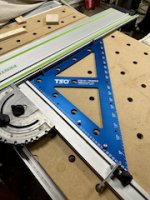I had struggled for an embarrassingly long time squaring an MFT/3 setup successfully. Took classes - (not square); read posts - (not square); watched videos - (not square); and simply gave up and used the 20mm holes and dogs.
I had purchased a very expensive, and fancy "Red" square to align the MFT and the square was advertised just for this purpose.
I finally purchased a "Blue" square - and magically, I had square cuts. As I found out, the expensive Red "square" simply was not delivered to me 90 degrees square.
Moral of story is of course, "Never assume, always check" and you won't waste as much time and frustration as I did. Should have known better - but the reputation of the company was that of near perfection. Live and learn.
I had purchased a very expensive, and fancy "Red" square to align the MFT and the square was advertised just for this purpose.
I finally purchased a "Blue" square - and magically, I had square cuts. As I found out, the expensive Red "square" simply was not delivered to me 90 degrees square.
Moral of story is of course, "Never assume, always check" and you won't waste as much time and frustration as I did. Should have known better - but the reputation of the company was that of near perfection. Live and learn.


